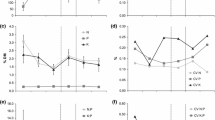Abstract.
Positive relationships between species richness and ecosystem processes such as productivity or nitrogen cycling can be the result of a number of mechanisms. We examined how species richness, biomass, and legume presence, diversity, and abundance explained nitrogen dynamics in experimental grassland plots in northern Sweden. Nitrogen concentrations and δ15N values were measured in plants grown in 28 mixtures (58 plots) including 1, 2, 4, 8 or 12 local grassland species over four years. Values for δ15N declined over time for all three functional groups (grasses, legumes, and non-leguminous forbs), suggesting greater reliance on N fixed by legumes over time by all species. Above ground percent nitrogen (%N) also declined over time but root %N and total N did not. Path analysis of above ground data suggested that two main factors affected %N and the size of the N pool. First, higher plant diversity (species richness) increased total N through increased biomass in the plot. Although in the first two years of the experiment this was the result of a greater probability of inclusion of at least one legume, in the last two years diversity had a significant effect on biomass beyond this effect. Second, percent legumes planted in the plots had a strong effect on above ground %N and δ15N, but a much smaller effect on above ground biomass. In contrast, greater plant diversity affected N in roots both by increasing biomass and by decreasing %N (after controlling for effects mediated by root biomass and legume biomass). Increased legume biomass resulted in higher %N and lower δ15N for both non-legume forbs and grasses in the first year, but only for grasses in the third year. We conclude that a sampling effect (greater probability of including a legume) contributed towards greater biomass and total N in high-diversity communities early on in the experiment, but that over time this effect weakened and other positive effects of diversity became more important.
Similar content being viewed by others
Author information
Authors and Affiliations
Additional information
Electronic Publication
Rights and permissions
About this article
Cite this article
Mulder, C., Jumpponen, A., Högberg, P. et al. How plant diversity and legumes affect nitrogen dynamics in experimental grassland communities. Oecologia 133, 412–421 (2002). https://doi.org/10.1007/s00442-002-1043-0
Received:
Accepted:
Published:
Issue Date:
DOI: https://doi.org/10.1007/s00442-002-1043-0




